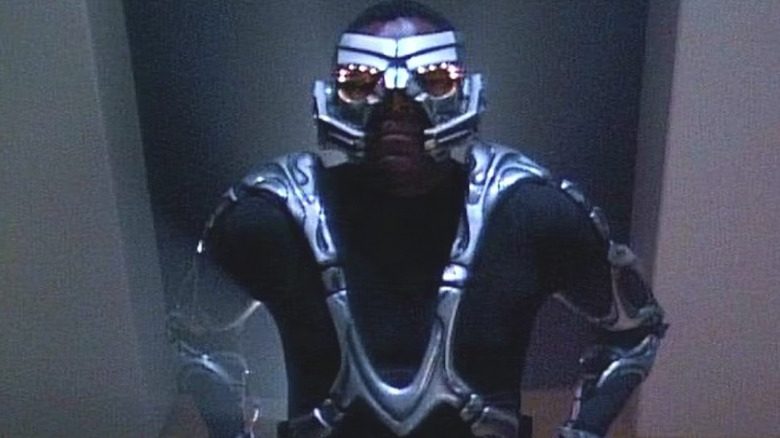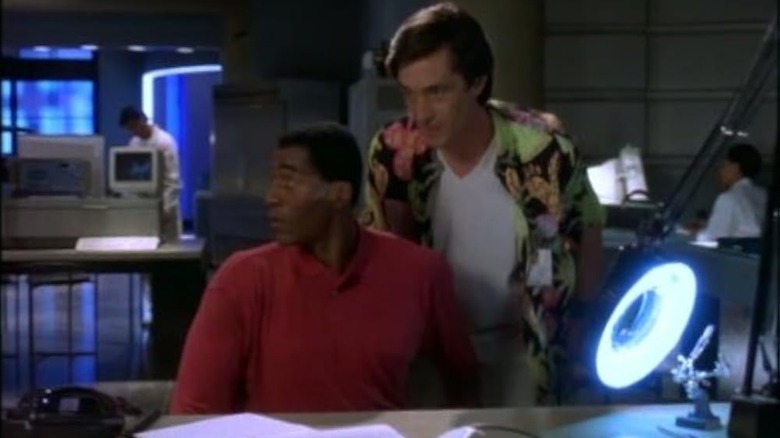Long Before Spider-Man, Sam Raimi Created A Forgotten '90s Superhero Series
We may receive a commission on purchases made from links.
Nearly a decade before directing "Spider-Man," Sam Raimi gave the world "M.A.N.T.I.S."
To answer the most burning question right away, "M.A.N.T.I.S." stands for Mechanically Augmented Neuro-Transmitter Interception System. It's the nickname that Dr. Miles Hawkins (Carl Lumbly) gave to the elaborate metal exoskeleton that he strapped around his body to fight crime. Dr. Hawkins had previously been paralyzed from the waist down after being shot in the spine by the police while trying to rescue a child in peril during a riot. He tried to sue the police department, but instead found a racist conspiracy designed to keep the city's Black population oppressed. Moved to justice, Dr. Hawkins invented the M.A.N.T.I.S. exoskeleton to help him walk. The exoskeleton worked better than he could have possibly imagined, though, granting him superhuman strength. He elected to become a bug-inspired superhero, doling out justice and confronting police corruption.
To round out his superhero accoutrements, Dr. Hawkins also outfitted his exoskeleton with paralysis darts he could fire from his fists, and a bodysuit that could deflect bullets. He also invented a flying car he called the Chrysalis. He had a few confidants, including the co-inventor of his exoskeleton, John Stonebreak, played by Roger Rees. His police contact was Lieutenant Leora Maxwell, played by Galyn Görg. The police chief was played by reliable character actor Gary Graham from "Alien Nation," "Star Trek," and "Robot Jox."
"M.A.N.T.I.S." was co-created by Raimi and Sam Hamm (the screenwriter of the 1989 "Batman" movie), and debuted in the summer of 1994 on Fox. The show aired on Friday nights, however, meaning that the network didn't have a lot of faith in it. The series only lasted for 20 episodes, coming to an end in March of 1995. A few years later, the Sci-Fi Channel picked up the series, and found that two additional episodes had never aired. Sci-Fi finally presented the full 22-episode run of the series. Technically, "M.A.N.T.I.S." lasted until September of 1997.
It's also pretty great, in that mid-budget, '90s sci-fi kind of way.
M.A.N.T.I.S. was serious, until it wasn't
Given the origin of the hero, one might think "M.A.N.T.I.S." was a hard-hitting series about racial justice, meant to appropriately vilify the police and provide justice for the Black community, which was topical in 1994. The beating of Rodney King had only occurred three years prior. The following May, the LAPD cops were let off the hook, inspiring six days of riots. "M.A.N.T.I.S.", on its surface, was created to address the righteous rage over the brazen racism that cops constantly express. This seemed like a far more political effort than anything Raimi had previously done; he was typically a more whimsical filmmaker.
But the sense of racial justice in "M.A.N.T.I.S." eventually became only one of its features. It very quickly evolved into a pretty wacky show, involving time travel, parallel universes, superpowered villains, and an invisible dinosaur (!). The police conspiracies transformed from natural corruption into a villainous plot enacted by a wicked Lex Luthor-type businessman named Solomon Box, an old friend of Dr. Hawkins. Brion James played Solomon Box, but was eventually replaced by "Dirty Harry" actor Andrew J. Robinson, who had also appeared in things like "Hellraiser" and "Star Trek: Deep Space Nine." Like with many shows, the pilot episode was very different from the series that followed. Most of the characters were different in the pilot, as was the M.A.N.T.I.S. costume (he wore a trench coat at first).
And, yes, the stories were all silly. One episode sported a villain who shunted his consciousness into a computer. Another kidnapped M.A.N.T.I.S. and replaced him with a clone. There was a mad scientist who spliced jellyfish DNA into human subjects, making jellyfish people.
Most of "M.A.N.T.I.S." was directed by recognizable TV vets whose names will be familiar to fans of "The X-Files." Rob Bowman, David Nutter, Joe Napolitano, Kim Manners, and Cliff Bole all took a crack at directing.
M.A.N.T.I.S. is better than Sam Raimi's first Spider-Man movie
"M.A.N.T.I.S" was Sam Raimi's first foray into television, and he would move on to developing "Xena: Warrior Princess" while it was still on the air. The people who remember watching "M.A.N.T.I.S." in 1994 and 1995 likely remember its tone to be a little dark, especially in its first few episodes. A revisitation, however, reveals that it was just as silly as it sounds ... but while also dealing with some serious themes of racial justice. Raimi, of course, had learned to balance violent superhero mayhem with light comedic whimsy in his 1990 film "Darkman," and he would try to strike that balance again in 2002 with his adaptation of "Spider-Man," a film so successful, it spawned two sequels and a crossover movie.
Call me kooky, but "M.A.N.T.I.S." does a better job of balancing its cartoonishness and its drama than Raimi's first Spider-Man movie. The first Spider-Man mishandled its more personal elements by reducing them to overplayed melodrama, while its action was weirdly low-energy. Raimi would improve greatly by the time he got to "Spider-Man 2." Raimi, of course, didn't direct "M.A.N.T.I.S.," but he did come up with the story, developed the premise, and served as executive producer, so it's always going to be tempting to look for his creative input. And it seems he wanted a fantastical, adolescent, bonkers superhero show that still had some palpable, real-world themes to dig in to. He succeeded.
Its adolescent nature, however, kept viewers away, and its Friday night time slot surely didn't attract anyone. It slipped out of the public consciousness quickly, only remembered by a small handful of nerds who stayed home on Fridays. It can still be found on Apple TV, purchasable for $1.99 an episode. If one is a fan of 1990s sci-fi TV (and who isn't, really?), it's still worth a look.


